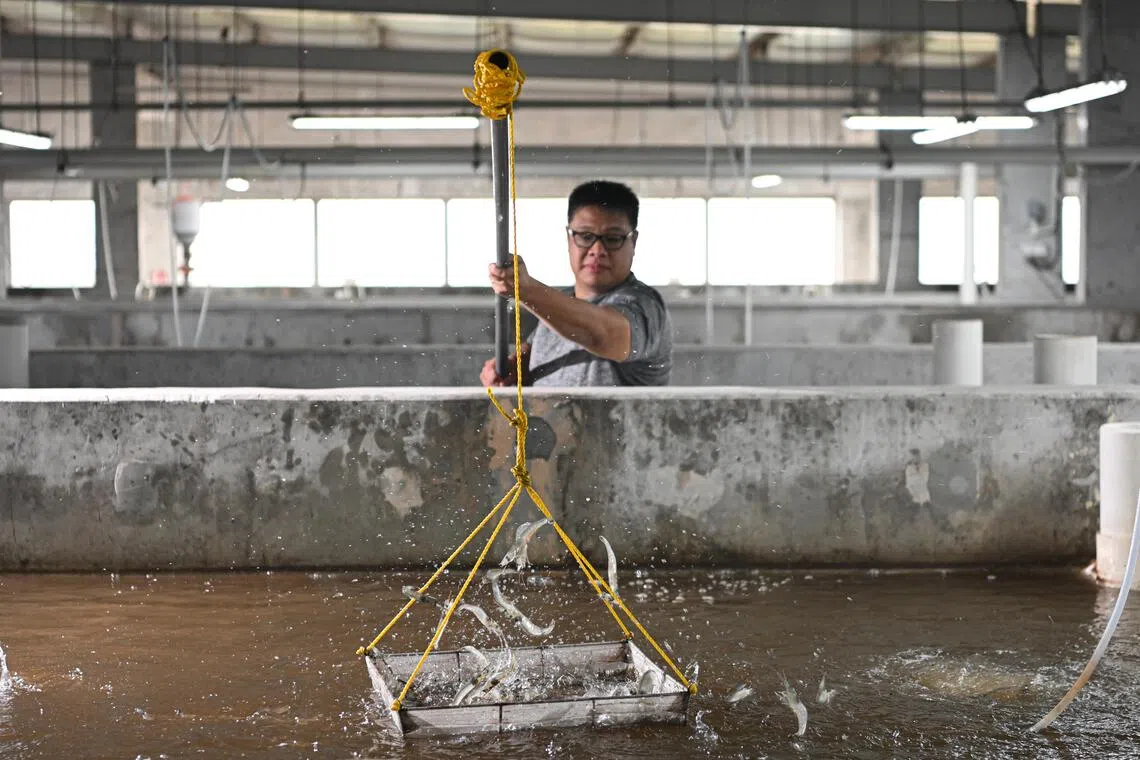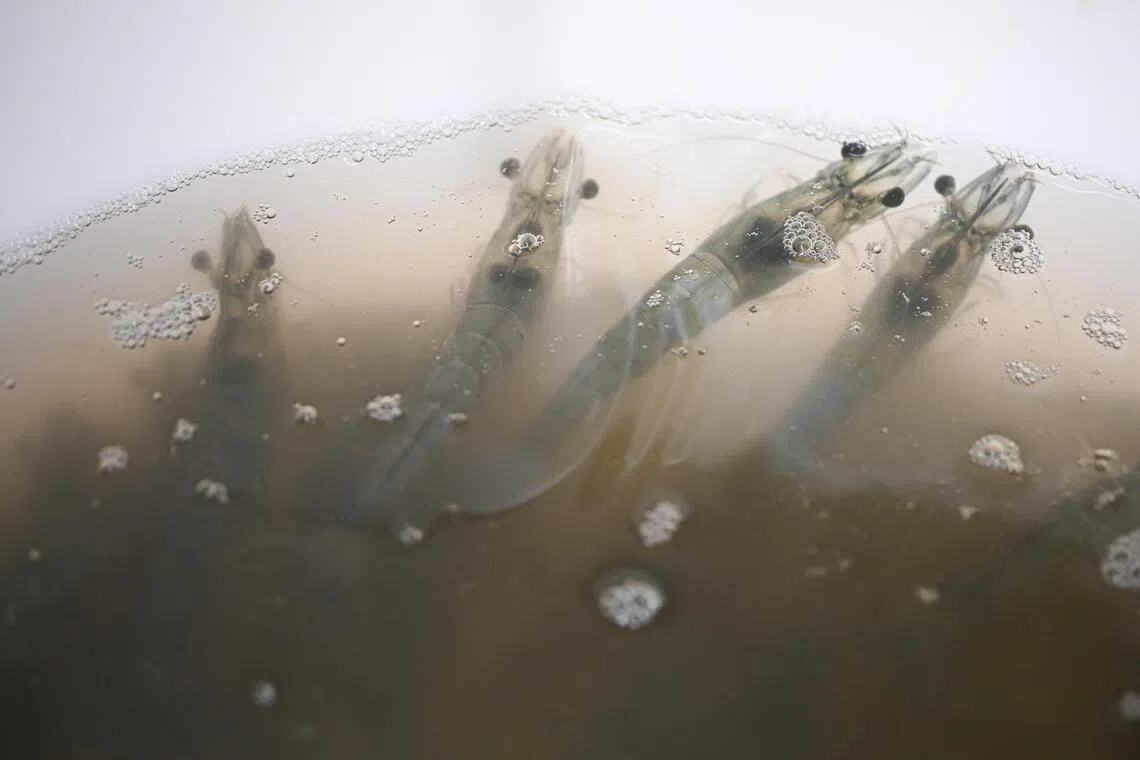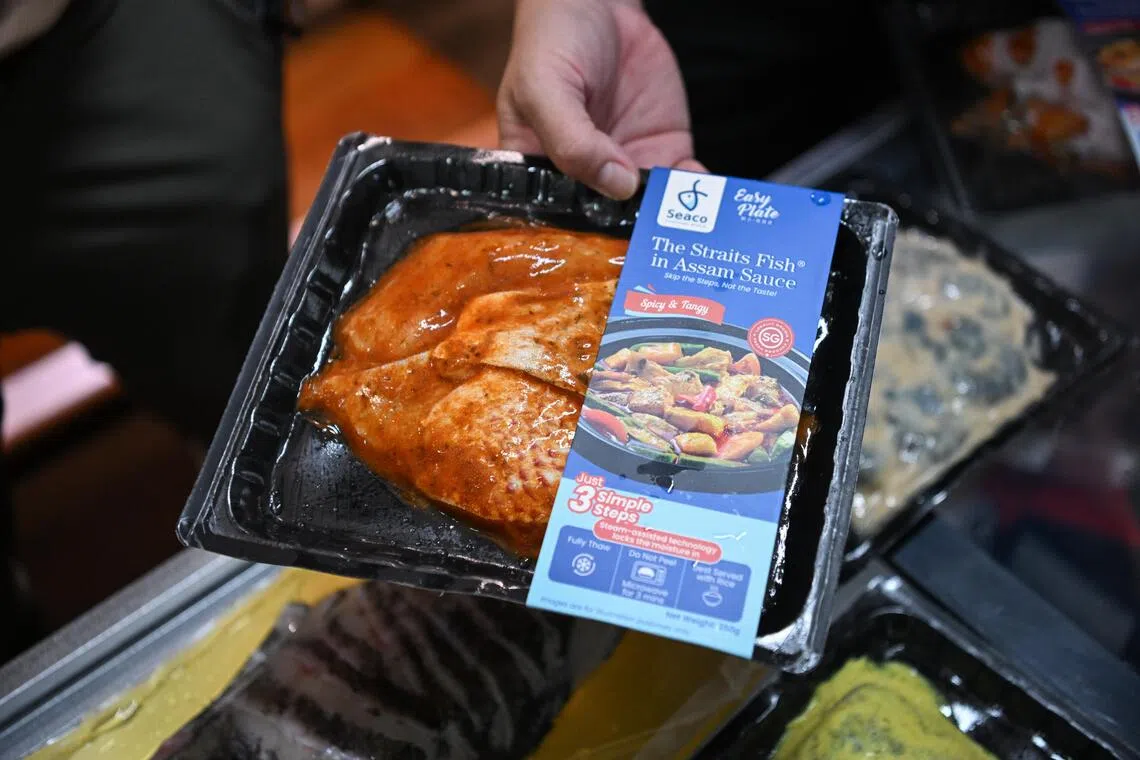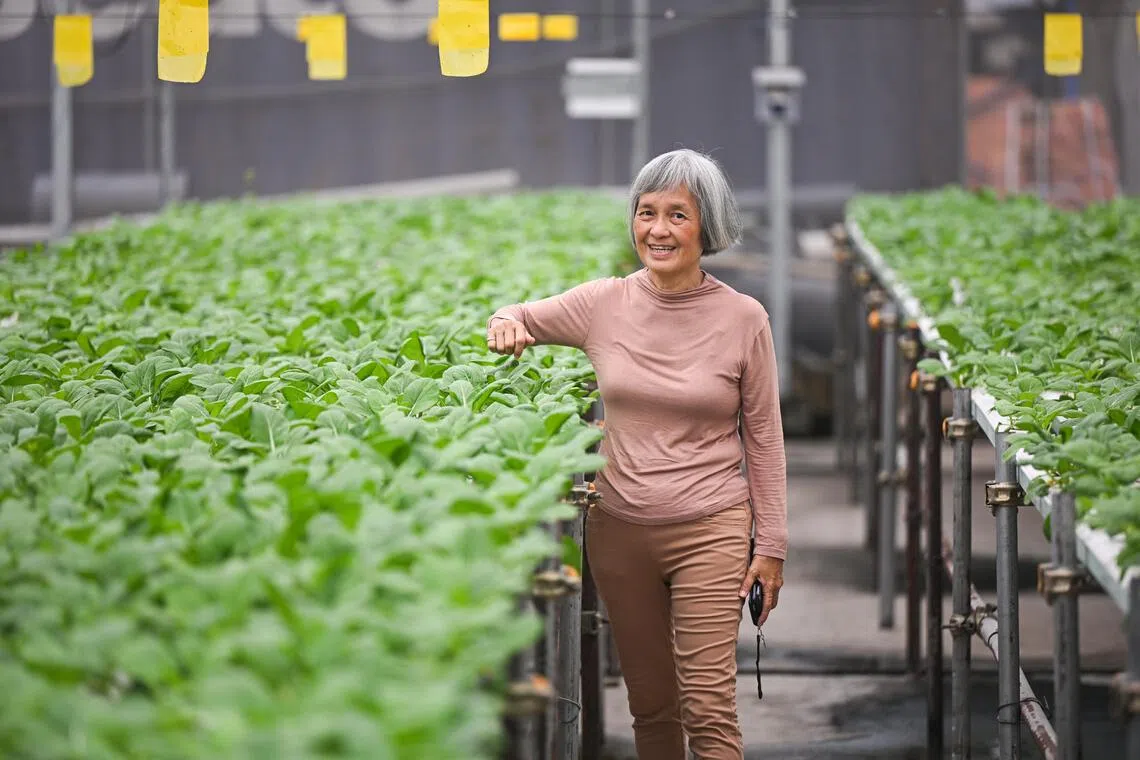Singapore farms press on with smarter strategies and collective efforts to cut costs
Sign up now: Get ST's newsletters delivered to your inbox

Mr Koh Foo Weng, a facility manager at AquaChamp's Neo Tiew Crescent building, scooping out vannamei shrimp.
ST PHOTO: AZMI ATHNI
Follow topic:
- AquaChamp revives a dormant aquaculture building, rearing shrimp and grouper using indoor farming, aiming for better yields and supplying seafood to restaurants.
- SAFEF initiatives, like shared delivery and transport, reduce costs and support local farms by easing logistical challenges and improving employee commutes.
- Farms focus on premium markets, optimise plant science, and use climate-appropriate solutions to achieve profitability, after closures of high-tech vertical farms.
AI generated
SINGAPORE - Despite upheavals facing Singapore’s farming sector, new farming operations are quietly taking shape in an eight-storey aquaculture building that had stood dormant for two years.
In March 2025, AquaChamp took over the former Apollo Aquaculture Group’s building
AquaChamp’s drive to reignite the multi-storey farm is but one green shoot sprouting from Singapore’s tough farming soil. Several farms continue to persevere, and have made recent collective efforts to reduce production costs.
The aquaculture building was among several local farms and industry players that the media visited on Nov 25, three weeks after Singapore’s 30 by 30 farming target was replaced by revised targets due in 2035
The aim now is to produce 20 per cent of the country’s consumed fibre, such as leafy vegetables, and 30 per cent of protein, including seafood and eggs, by 2035.
The media visit was hosted by the Singapore Agro-Food Enterprises Federation (SAFEF), an industry-led organisation which aims to improve the productivity and profitability of local farms.
At least two aquaculture firms have bowed out because of financial difficulties and the tough competition with cheaper imports in a small market. Besides Apollo Aquaculture, Barramundi Group also gave up deep-sea farming in the southern waters in 2023 after a fish virus outbreak. Its open-net cages will be taken over by Singapore Aquaculture Technologies.
While two storeys of the tall, blue building are operational, only a portion of the tanks are filled with fish and shrimp as the AquaChamp management did not want to be overly ambitious.
“A lot of (sea-based fish farms) have been shutting down. So this was a good opportunity for us to try a closed environment, indoor farming, for us to have better yield,” said Mr Koh Foo Weng, facility manager of the building, which currently has fewer than 15 employees.
AquaChamp has also secured restaurants to supply its seafood to, and is in talks with Singapore Airlines. The farm’s live vannamei shrimp are also sold in three Giant supermarkets under SAFEF’s vannamei shrimp brand, The Dot Shrimp.
Given its higher utility and equipment costs as a land-based farm, AquaChamp said it has to rear more premium species like grouper and coral trout.

Vannamei shrimps farmed by Aquachamp on Nov 25.
ST PHOTO: AZMI ATHNI
SAFEF’s chief executive Ken Cheong is hopeful that AquaChamp will be viable.
“They watched the cost (pressures) better, understanding the species and market segment, and not over-stretching themselves. Their approach is economically quite sound,” he said.
Local produce farms face the same pressures. Plagued by high energy and upfront investment costs, several high-tech vertical farms have shut down or filed for liquidation,
To compete with cheaper imports, several existing farms have been setting themselves apart by growing gourmet mushrooms and Western leafy greens like kale and herbs, targeting the premium, organic market and restaurants.
SAFEF is trying to help in other ways. It has initiated a shared delivery service, picking up produce from growers in remote Lim Chu Kang and seafood from farms along the Johor Strait to deliver to customers and distributors. This has reduced costs for farms.
While the shared service is still in the early stages, it has potential to keep delivery costs to 10 per cent of the total cost of each harvest, said Mr Cheong. At times, the delivery costs can be half of a product’s value.
“Some farms are suffering because they have to rely on expensive delivery services,” he added. The delivery services are expected to be scaled up with fixed routes in early 2026.
From Dec 1, SAFEF will also start a shuttle bus service to take farm employees from Kranji MRT station to the Lim Chu Kang farms, which are poorly served by public transport. The shuttle bus will charge a monthly fee of about $190 for each person.
SAFEF said better transportation could entice more locals to work in the farming sector, and make travelling easier for interns.
SAFEF, which has more than 50 members, is also helping farms market their produce and get it on supermarket shelves under umbrella brands.
Shrimp from four farms are sold under the banner of The Dot Shrimp, and in 2026, a separate brand for gourmet mushrooms will be formed, with three farms participating.
SAFEF’s branding initiative started in late 2023, with The Straits Fish label for a handful of sea-based tilapia farms jointly producing the fish at scale.
It also works with food processing firms to bring the fish to market. TheSeafoodCompany, for instance, created ready-to-eat tilapia fillets in assam sauce, which are sold for $11.90 at FairPrice.
To boost local tilapia farms’ demand, TheSeafoodCompany is in talks with partners in the US and Australia to export the ready-to-eat packages, said its managing director Kenneth Chia.

Ready-to-eat tilapia fillets prepared by TheSeafoodCompany.
ST PHOTO: AZMI ATHNI
And while vertical farming could be a solution for land-scarce Singapore, its high costs are a formidable obstacle to overcome.
Some farms told ST that agri-tech firms should not be too caught up in the newest technology that will drive up costs and affect revenue. It is more important to get the plant science right and work with Singapore’s climate.
Ms Sharon Goh, director of CropCiti, which farms Asian greens, said: “I believe in the natural environment, weather and climate. Make use of the sunlight instead of LED lights that cost a lot of money.”
CropCiti’s greenhouses at its farm in Neo Tiew grow vegetables such as chye sim, bayam, local lettuce and bok choy through hydroponics.

Ms Sharon Goh, director of CropCiti, which farms Asian greens.
ST PHOTO: AZMI ATHNI
To ventilate the crops, solar-powered industrial fans are attached to each greenhouse, instead of energy-guzzling blowers. Ms Goh channels more resources into formulating nutrients for her crops.
Local firm Tomato Town’s managing director Webster Tham added that costly climate-controlled indoor facilities may not be necessary if farms choose the right crops that can grow between temperatures of 28 deg C and 34 deg C.
He said: “Adopt the right solution instead of the latest tech. From there, develop the best practices and technologies that suit Singapore’s climate better.”


